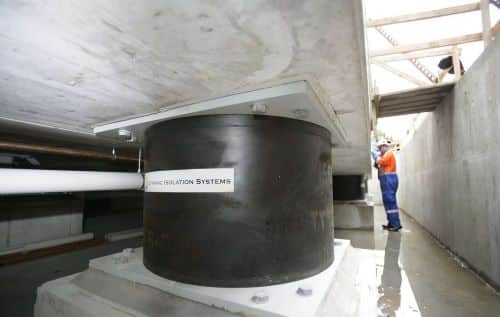A recent catastrophic earthquake in North Africa that claimed thousands of lives has caused civil and environmental engineering experts to emphasize the need for quake-proof buildings. Read on to discover their recommendations.
In the late hours of 8 September, a powerful earthquake originated beneath the formidable Atlas Mountains, a prominent geological feature across North Africa. The quake’s epicenter was approximately 75 kilometers (45 miles) from Marrakech, a renowned tourist hotspot in Morocco.
The seismic event registered a substantial magnitude of 6.8 that resulted in at least 2,901 lives lost and more than 5,500 injuries. This seismic event served as a grim reminder of Morocco’s vulnerability to such disasters, with the last comparable earthquake occurring in 1960 in Agadir, claiming the lives of 12,000 people.
Tens of thousands of earthquakes occur annually around the world. While some cause little to no harm, others, such as the event near Morocco, result in massive loss of lives and disruptions to local economies.
The recent North Africa quake is a stark reminder of the potential devastation that can occur in the absence of quake-resistant buildings.
Understanding the Causes of Building Collapse During Earthquakes
According to civil and environmental engineering experts, the significant human toll resulting from the Morocco earthquake can be attributed to the event’s timing. Striking close to midnight, many victims were caught unaware, fast asleep within the confines of their homes.
Conversely, experts have pointed to a deficiency in disaster-resilient infrastructure and suboptimal town planning as factors that likely contributed to the high casualty rate. Traditional construction techniques, prevalent in many parts of Morocco, left older buildings ill-equipped to withstand an earthquake of this magnitude, as they were not designed with disaster resilience in mind.
In an interview with Deutsche Welle, a prominent German news agency, Mehrdad Sasani, a civil and environmental engineering professor at Northeastern University in the United States, emphasized this concern. He highlighted that mud-brick construction and masonry without “reinforcement” were standard practices, rendering these structures vulnerable.
While materials like concrete, gravel, and mud are favored in Morocco for their ability to withstand scorching heat, they prove inadequate in earthquake resistance. These houses are primarily designed for extreme temperature resilience rather than seismic durability.
Considering these challenges, architects and civil engineers are prompted to explore innovative solutions for constructing earthquake-resistant buildings. So, what key points do they follow?
Designing Earthquake-Resistant Buildings: Key Strategies
Architects and civil engineers meticulously evaluate methods to mitigate building design and construction risks. Adherence to relevant codes constitutes a fundamental approach in this regard.
Beyond the universally recognized international building codes governing the planning, construction, modification, and upkeep of both commercial and residential structures, seismic codes play a pivotal role.

Although structures engineered to endure earthquakes may not boast outwardly distinctive features, their robustness in the face of seismic events hinges on several critical factors. Here are five key elements that enhance their resilience in the event of such disasters:
Solid Foundations
Flexible foundations, like pads or reinforced concrete slabs on sand cushions, keep buildings stable during quakes.
Seismic Dampers
These shock absorbers, developed initially with NASA, protect buildings by absorbing seismic energy. Various sizes and materials are available, including graphene-coated rubber pads.
Effective Drainage
Proper drainage prevents structural issues caused by pooled water. Earthquake drains, strategically placed, counter liquefaction in sandy soils, aiding stability.
Structural Reinforcement
Engineers employ methods like shear walls, braced frames, and diaphragms to redirect lateral forces and strengthen building structures. The level of reinforcement depends on a building’s height.
Ductile Materials
Materials with high ductility, like structural steel or innovative alternatives like eco-friendly ductile cementitious composite, can absorb significant energy without failing. In resource-constrained areas, emerging solutions include earthquake-resistant materials like bamboo and lightweight reflective roofing.

Advancing Earthquake Resilience Through Innovation
In pursuing enhanced earthquake resilience, what innovative approaches can aid Morocco in its reconstruction efforts? The World Economic Forum (WEF) proposes adopting “base isolation” systems, which physically separate buildings from their foundations using springs or runners.
This design ensures that the building remains detached from the ground when an earthquake occurs, preventing stress on its structural integrity, the WEF said. This technology has been successfully deployed in earthquake-prone regions such as Japan and Chile.
While the benefits of base isolation systems are evident, the associated costs can often be prohibitively high. Consequently, other nations grappling with seismic threats have explored simpler, cost-effective strategies.
Nepal, also susceptible to frequent earthquakes, has incorporated affordable materials like straw bales, used tires, and plastic bottles into construction techniques, offering a sustainable and economical alternative.
The South African Housing & Infrastructure Fund is pioneering earthquake-resilient 3D-printed concrete houses in various parts of Africa. This innovative approach provides cost-effectiveness and allows for increased customization, enabling the design of structures capable of withstanding the erratic forces generated by earthquakes.
Recognizing that building damage remains a leading cause of fatalities during earthquakes, the implementation of intelligent building engineering not only safeguards property and infrastructure from collapse but, most importantly, saves lives and prevents injuries.
References
5 Keys to Designing Earthquake-Resistant Buildings


